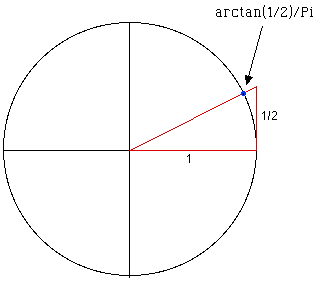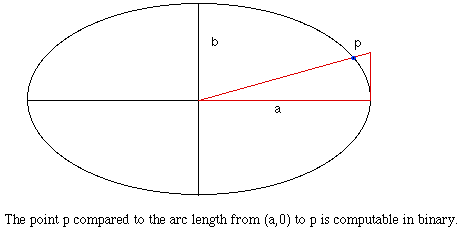The Computation of Certain Numbers Using a Ruler and
Compass
Simon Plouffe
Dépt. Mathématiques
Université du Québec à Montréal
Montréal H2X 3Y7, CANADA
Email address:
simon.plouffe@sympatico.ca
- Abstract: We present a method
for computing some numbers bit by bit using only a ruler and
compass, and illustrate it by applying it to arctan(X)/π. The
method is a spigot algorithm and can be applied to numbers
that are constructible over the unit circle and the ellipse. The
method is precise enough to produce about 20 bits of a number,
that is, 6 decimal digits in a matter of minutes. This is
surprising, since we do no actual calculations.
- Keywords: Binary expansion,
A004715
of the
On-Line Encyclopedia of Integer Sequences,
constant, ruler and compass construction, π.
-
- 1. Introduction
-
- It is known that rational numbers of the form 1/q can be
computed with a ruler and compass in small bases. See [4] for details. The rational numbers
computable by this method are precisely those for which q is the
number of sides of a regular polygon that can be constructed with
ruler and compass; that is, q must be a product of distinct Fermat
numbers that are primes [5],
see also the
Treasure
Trove of Mathematics.
-
- From those facts, one can ask: are there other points on the
unit circle that can be constructed? The answer is obvious: any
line constructed on the plane that crosses the unit circle
somewhere defines a point from which the binary expansion can be
calculated. We understand here that we consider the arc length
compared to the unit circle. When we consider a rational number
like 2/3 we mean in fact exp(2*π*I*2/3), that is, the arc length
of 2/3 compared to 2*π on the unit circle. By taking a simple
construction of the angle arctan(1/2) then get an arc length of
arctan(1/2)/π = 0.147583.... A number that we believe should be
at least irrational. We also remark that the point defined by the
angle of arctan(1/2) has algebraic coordinates (2/5*sqrt(5) and
1/5*sqrt(5)), and that this point (on the unit circle) is
apparently not a rational multiple of π. We do not know if
there is a proof that this number is irrational.
-
- Second, the arctan function is a log (with complex values) and
π is also a log with complex values. This means that our
construction is a ratio of logarithmic values.
-
- 2. The construction of arctan(1/2)/π and
the computation
-

- The coordinates of the blue dot are (2/5*sqrt(5),
1/5*sqrt(5)).
- Each subdivision of the circle is equivalent to a
rational point, here π/2 is 0.01 in binary = 1/4.
-

-
- Only the first quadrant is necessary for the computation, see
the construction after 11 steps.
-
-
- At each step we double the angle and when the point falls in
the first quadrant we take the sign of the angle. If the sign is +
then we set that the corresponding bit value is 0 and 1 when the
sign of the angle is -. By doing it by hand for real, errors
accumulate and eventually there is an ambiguity in the sign since
at each step there is an uncertainty about the exact position of
the point. The limit is somewhere around 20 bits. I could easily
produce (with little care) the first 17 bits of the number
arctan(1/2)/π. Note: the construction is done on a plain white
paper and could be done on the sand in fact with small precision.
-
-
- 3. Other numbers.
-
- Since we can compute any point that lies on the unit circle
then any construction that cuts that circle is computable. This
includes numbers of the form arctan(A)/π where A is algebraic and
constructible with a ruler and compass. According to Borwein and
Girgensohn [2], it is possible
to compute bit by bit a number like such as (3)/log(2), but the
geometrical construction necessary for that implies the use of a
rectangular grid Z x Z.
-
- 4. Application to the ellipse
-
-
- The properties of the circle are not unique, it is also shared
with the ellipse and the lemniscate. In this context it means that
if we can construct an angle that crosses the ellipse of ratio a/b
then we can compute the binary expansion of the position of that
point compared to the arc length of the ellipse. The same
can be applied to the lemniscate.

-
- 5. An experimental approach to search for
other solutions
-
- The next step in this is to ask whether we can combine values
of arctan(X)/π to produce other numbers like sqrt(2). From the
classical theory of π (Lindemann's proof of the transcendence of
π), it is not possible to get 1/π from a geometrical
construction. In this context it means that we can't construct an
arc length of 1 radian with the ruler and compass. 1 radian has an
arc length of 1/π. It would mean that we can construct the number
sin(1) and cos(1). The only way I see to produce an example is to
try experiments with values of arctan(X)/π where X is a
constructible algebraic number.
-
- We have to understand here that we deal with an inverse
problem. The equation arctan(1/2)+arctan(1/3) = π/4 translates (in
arc length), to 1/8 in binary. π/4 = arctan(1) and this number
has an arc length of 1/8 compared to the full circle of 2*π.
-
- Open questions
-
- Can this process could be applied to other types of numbers?
(Like sqrt(2)).
- Since we can use the first quadrant only (and not a full
circle), can we extend this idea to have only a very small portion
of the unit circle and push the precision of the computation
further?
- Are there any simpler number? Or in other words: Is
arctan(1/2)/π the simplest example?
- Is arctan(1/2)/π an irrational number? (Hint: π/4 =
arctan(1/2)+arctan(1/3) and we know that π is irrational).
- Is there a bit pattern in arctan(1/2)/π? Is the binary
expansion of that number in fact a rule for constructing
something that we do not know? See sequence
A004715
of the E.I.S.
-
-
- 6. Bibliography
-
-
- [1] Simon
Plouffe, work done during the years 1974 to 1983.
-
- [2] J. M. Borwein and R. Girgensohn, Addition theorems
and binary expansions, Canadian J. Math. 47 (1995) 262-273.
-
- [3] Plouffe's constant at the site:
Favorite
Mathematical Constant of Steve Finch, 1996.
-
- [4] Simon Plouffe,
The
reflection of light rays in a cup of coffee or b^n mod p,
Conference, Hull (Canada), October 21, 1979, Congrès des
Mathématiciens du Québec.
-
- [5] C. R. Hadlock, Field Theory and Its Classical Problems (Carus Mathematical Monographs, No. 19), 1979.
-
- [6] N. J. A. Sloane and S. Plouffe, The
Encyclopedia of Integer Sequences. San Diego, Calif.: Academic
Press, 1995. Also see the
On-Line
Encyclopedia of Integer Sequences.
-
(Related to sequences
A004715
and
A028999
.)
Received Jan. 1, 1998; published in Journal of Integer Sequences Jan. 30, 1998.
Return to
Journal of Integer Sequences home page




